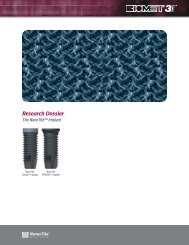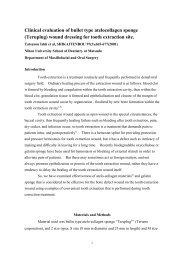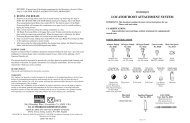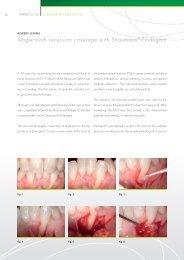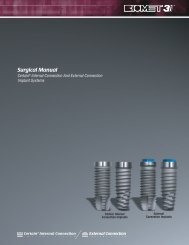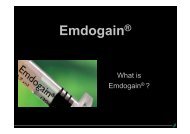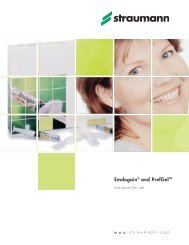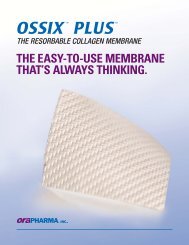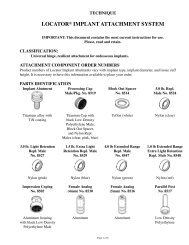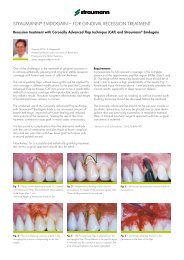LOCATOR® BAR ATTACHMENT SYSTEM - Proscan
LOCATOR® BAR ATTACHMENT SYSTEM - Proscan
LOCATOR® BAR ATTACHMENT SYSTEM - Proscan
You also want an ePaper? Increase the reach of your titles
YUMPU automatically turns print PDFs into web optimized ePapers that Google loves.
NOTE: Due to the additional height required for the Laser Bar Females (Zest order #8588 and<br />
#8590), they require the use of 2 White Block-Out Spacers stacked on top of each other for proper<br />
block out. It is also necessary to block out all undercuts beneath the bar to prevent the added<br />
acrylic resin from locking the denture onto the bar.<br />
3. Insert a Locator Titanium Cap with Yellow Bar Processing Male (Zest order #8028 Package) onto each<br />
Locator Bar Female, leaving the White Block-Out Spacer beneath it. The Yellow Bar Processing Male<br />
will maintain the overdenture in the upper limit of its vertical resiliency during the processing procedure.<br />
4. Prepare a recess in the denture to accommodate the protruding Locator Denture Cap Male. There must<br />
be no contact between the denture and the titanium cap. If the denture rests on the metal cap, excess<br />
pressure on the implant will result.<br />
5. Use the Chairside Dental Attachment Light Cure Kit (Zest order #9403) to light cure bond the Locator<br />
Yellow Bar Denture Cap Male into the denture, or mix a permanent self-curing acrylic and place a small<br />
amount in the recess of the denture and around the metal cap of the Yellow Bar Processing Cap Male.<br />
6. Insert the denture into position in the oral cavity. Guide the patient into occlusion, maintaining a<br />
proper relationship with the opposing arch. Maintain the denture in a passive condition, without<br />
compression of the soft tissue, while the acrylic sets. Excessive occlusal pressure during the setting<br />
time may cause tissue recoil against the denture base and could contribute to dislodging and wear<br />
of the nylon males.<br />
7. After the acrylic resin has cured, remove the denture and discard the white spacer. Use a bur to remove<br />
excess acrylic, and polish the denture base before changing to the final resilient nylon male.<br />
8. Use the Locator Male Removal Tool (attached to the Locator Core Tool, Zest order #8393) to remove<br />
the Yellow Bar Processing Male from the metal denture cap. The sharp circular edge on the end of the<br />
removal tool should be wedged tightly down into the bottom of the Yellow Bar Processing Male so that<br />
it will catch the inside of the yellow plastic insert and pull it at an angle out of the metal housing.<br />
9. The Locator Male Seating Tool (contained in Locator Core Tool, Zest order #8393) is used to firmly<br />
push a Locator Replacement Male into the metal denture cap. The replacement male must seat securely<br />
into place, level with the rim of the cap. Use of multiple Locator attachments (3 or more) in the same<br />
dental arch may require use of the 3.0 lbs. (light retention) pink colored Replacement Male No. 8527,<br />
or 1.5 lbs. (extra light retention) blue colored Replacement Male No. 8529, for easier removal of the<br />
prosthesis by the patient.<br />
NOTE: The Replacement Male will not stay on the tool when it is turned upside down due to the<br />
varying sizes of males available. It is best to hold the denture with the base side down and snap the<br />
male into the metal denture cap.<br />
10. Instruct the patient in the path of insertion. Have the patient insert and remove the appliance several<br />
times.<br />
C. LOCATOR MALE PLACEMENT BY THE LABORATORY<br />
1. Placement of the desired type of Locator Bar Female into the bar must be completed (see Section A)<br />
before beginning the procedure for placement of the Locator Male.<br />
2. Place a Locator Impression Coping with Black Processing Male (Zest order #8505) onto each Locator<br />
Bar Female.<br />
3. Take an impression using a firm body impression material, exercising caution not to compress the<br />
soft tissue. The Locator Impression Coping is designed with minimum retention to be picked up with<br />
the impression material.<br />
4. Snap a Locator Female Analog (Zest order #8530) onto each Impression Coping in the impression. The<br />
analog female must not fall off when turned upside-down with vibration.<br />
5. Pour the master cast. Upon separation, the Locator Female Analog is a part of the master cast replicating<br />
the position of the Locator Bar Female on the bar.<br />
Page of 8



